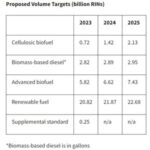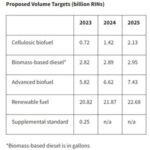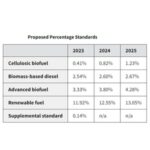Oral arguments held in challenge to EPA’s ACE rule
Energy Disrupter
ADVERTISEMENT
Oral arguments in a lawsuit challenging U.S. EPA’s Affordable Clean Energy Program were held before the U.S. Court of Appeals for the D.C. Circuit on Oct. 8. One portion of the arguments focused specifically on the program’s treatment of biomass co-firing.
The EPA released the final rule for its ACE program on June 19, 2020. The ACE program replaces the Obama-era Clean Power Plan and establishes emissions guidelines for states to use when developing plans to limit carbon dioxide at coal-fired power plants. While biomass co-firing was discussed as a potential compliance option in the proposed rule, the final rule specified that biomass co-firing cannot be used to comply with the ACE program.
The proposed version of the ACE rule asked members of the public to comment on the inclusion of forest-derived biomass as a compliance option for affected units to meet state plan standards under the ACE rule. Public comments were also solicited regarding the inclusion of non-forest biomass as a compliance option, and what value to attribute the biogenic carbon dioxide emission associated with non-forest biomass feedstocks.
In the final ACE rule the EPA said it received comments both supporting and opposing the use of biomass for compliance. “Upon consideration of comments and in accordance with the plain language of CAA section 111…, the EPA is now clarifying that biomass does not qualify as a system of emission reduction that can be incorporated as part of, or in its entirely, as [best system of emission reduction (BSER)],” the EPA wrote in the rule. “…[The] BSER determination must include systems of emission reduction that are achievable at the source. While firing of biomass occurs at a designated facility, biomass firing in and of itself does not reduce emissions of CO2 emitted from that source. Specifically, when measuring stack emissions, combustion of biomass emits more mass of emissions per Btu than that from combustion of fossil fuels, thereby increasing CO2 emissions at the source. Recognition of any potential CO2 emissions reductions associated with biomass utilization at a designated facility relies on accounting for activities not applied at and largely not under the control of that source, including consideration of offsite terrestrial carbon effects during biomass fuel growth, which are not a measure of emissions performance at the level of the individual designated facility. Use of biomass in affected units therefore not consistent with the plain meaning of ‘standard of performance’ and cannot be considered as part of the BSER.”
Within the rule, the EPA also states that “biomass fuel use opportunities are dependent upon many regional considerations and limitations—namely fuel supply proximity, reliability and cost—that prevent its adoption as BSER on a national level…Therefore, even is biomass firing could be considered a ‘system of emission reduction’ the EPA is not able to include the use of biomass fuels as part of the BSER in this action due to the current cost and achievability considerations and limitations discussed [within the rule].”
The EPA also said it received a range of comments both supporting and opposing the use of forest-derived and non-forest biomass feedstocks for compliance under the ACE rule, along with a range of comments regarding the valuation of CO2 emissions from biomass combustion. Some of those comments referenced the EPA’s 2018 policy statement regarding biogenic CO2 emissions in which the agency stated its intent to treat biogenic CO2 emissions from forest biomass and managed forests as carbon neutral in future agency actions.
“The construct of this final ACE rule necessitates that measures taken to meet compliance obligations for a source actually reduce its emission rate in that: (1) they can be applied to the source itself; and (2) they are measurable at the source of emissions using data, emissions monitoring equipment or other methods to demonstrate compliance, such that they can be easily monitored, reported and verified at a unit…” said the EPA in the rule. “While the firing of biomass occurs at a designated facility, biomass firing in and of itself does not reduce emissions of CO2 emitted from that source. Specifically, when measuring stack emissions, biomass emits more CO2 per Btu than fossil fuels, thereby increasing the CO2 emission rate at the source. Accordingly, recognition of any potential CO2 emissions reductions associated with biomass firing at a designated facility relies on accounting for activities not applied at and largely not under control of that source…, including consideration of terrestrial carbon effects during the biomass fuel growth. Therefore, biomass fuels do not meet the compliance obligations and are not eligible for compliance under this rule.”
The American Lung Association filed a petition for review challenging the ACE program in July 2019. The Biogenic CO2 Coalition is among the petitioners challenging the ACE rule as part of that lawsuit, arguing that coal-fired power plants should be able to achieve ACE compliance by co-firing biomass materials.
Attorney David Williamson represented the Biogenic CO2 Coalition during the Oct. 8 oral arguments. In his testimony Williamson argued that the EPA said the use of biofuels were disqualified for compliance with the ACE rule not because of science or a policy determination, but because Congress used the world “application” in CAA Section 111D, which limits the types of compliance measures. However, Williamson stressed that EPA never explained why Congress would have intended to foreclose using low-carbon biofuels when addressing greenhouse gases. He said EPA’s interpretation is impermissible in two ways, either of which requires remand.
First, he said, there is no indication that the text or structure of the statute that Congress actually did constrain compliance measures. EPA misapprehends a limit that simply doesn’t exist, Williamson said. Second, he argued that even if the definition of “application” extends to compliance measures, it’s the position of his client that EPA’s disqualification of biofuels is “impermissible and arbitrary” because biomass fuels actually do meet the criteria that the agency derived in the final rule.
A full audio recording of the Oct. 8 oral arguments can be downloaded from the U.S. Court of Appeals for the D.C. Circuit website. The discussion of biomass co-firing begins near the 7:23:00 mark of the eight hour-plus event.
















